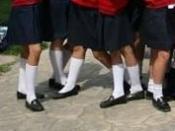Alexia Pickens
Mrs. Wolfe
AP English 11
19 February 2014
School Dress Code: A Research Paper
Figure.1 MS dress code. Jaymee.
Imagine a young man walking into a classroom wearing a pair of baggy jeans that are sagging seven inches below his waist, revealing his undergarments to the public. To prevent the frowzy presentation of young Americans, the school dress code was born. A dress code is a set of rules that governs the garments a person can wear in a particular setting. school dress codes have been in place since the 1950s and 60s when the schools were trying to diminish juvenile delinquency (stacie). Dress codes highlight a struggle between two strongly held values: the importance of focusing on school work versus the importance of freedom of expression.
Most schools have a dress code of some sort. Common dress code guidelines ban gang related clothing, offensive logos, midriff baring tops, and overly short skirts (Powell-Smith).
Dress codes, in their most basic form eradicate unruly clothing. People that support a more strict dress code believe that uniforms make a school more focused on learning and that they make schools safer.
Dress code that require the wearing of uniforms can be seen as beneficial for several reasons. According to surveys conducted by the NAESP (National Association of Elementary School Principals), 79 percent believe uniforms positively affected classroom discipline; 67 percent saw an improvement in student concentration; 62 percent noticed a positive effect on school safety; 72 percent increase in school spirit; 85 percent noted a better perception of the school by the community; and 75 percent indicated a positive effect on peer pressure among students (Daniels). Wearing a uniform is thought to have a positive impact on schools according to Don Woodard, a high school principal (Daniels). "Demeanor is better in...


